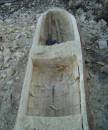Museum Collection
Kayuk
Two kayuks are stored in the Sholokhov Museum-Reserve, one of them is exhibited at the Vyoshensky memorial and historical complex.
A kayuk is a small flat-bottomed rowing boat, which is made from willow or oak. In the story "Foal" of M.A. Sholokhov we read:
“About ten minutes later, the squadron drove off the riverside and the first put its horse into the water, followed by it with a thunderous splash a squadron - one hundred and eight half-naked riders, as many different-colored horses. The saddles were transported in three kayuks.”
In the Upper Don, the kayuk was most often made of willow, since this tree grew on the banks of the Don in large numbers, and its wood does not dry out on the shore and glides well along the water, which is very important with numerous Don swirls and rifts. At first, in the floodplain of the river, a suitable tree was chosen (it should have a thick trunk), it was cut down, and then it was dragged by bulls or horses to where it was going to make the boat.
First of all, the trunk was cleaned of bark and twigs. Then the workpiece began to shape. At the same time, the top layer of the willow, immediately below the bark, in the place of the future feed, was tried to be kept as much as possible, since it has a special property of not letting moisture through. This made it possible to keep the wood intact and eliminated the need to prepare the boat for each navigation season. In the Don, the bow of the boat was already made higher, and the stern lower and slightly wider. The width of the boat depended on the thickness of the tree. Further, cuts were made in the center of the trunk and a special scraper hollowed out excess wood - they made a recess. 2 partitions were left inside, they served as stiffeners for the construction of the kayuk. After the boat was ready, its inside was burned so that subsequently the wood would be resistant to moisture and served the owner for a long time.
On the water the kayuk moves silently, it isusually controlled by a single oar. Since ancient times Cossacks have used it for fishing in quiet water, in the reeds.
The kayuk requires great managing skills. It is not stable on the water: as soon as it bends unsuccessfully, the boat instantly turns over and, like the old Cossack fishermen joked about this, a “kayuk” (in other words “the end”) comes. However, this does not detract from the popularity of the boat. Cossacks themselves like to say that sitting on a horse and controlling a kayuk are in their blood.
Lyudmila Kochetova














